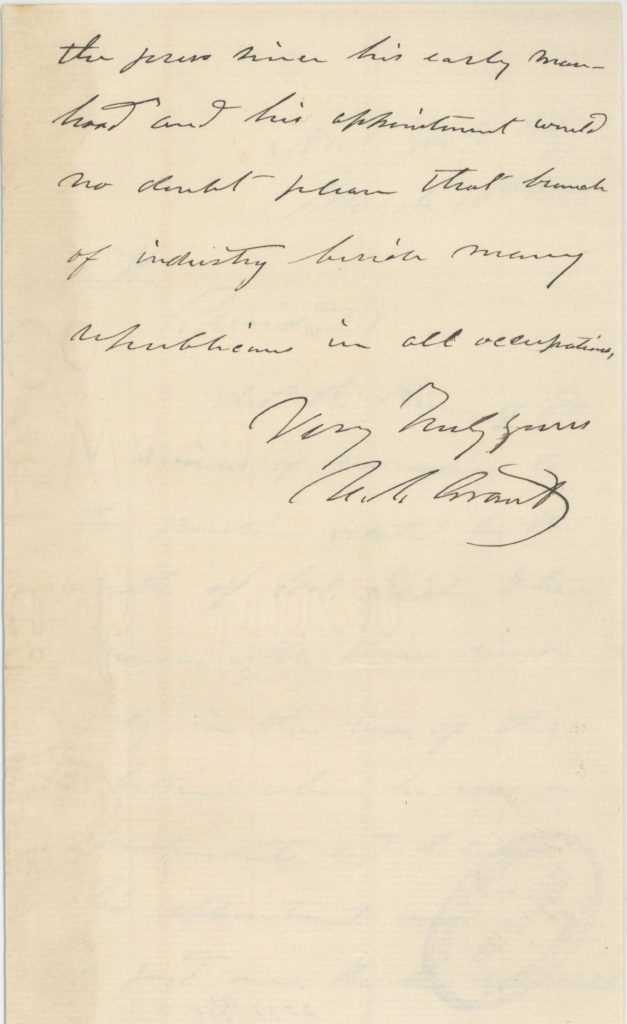Ulysses S. Grant Writes Sitting President Chester A. Arthur, Grant Citing “the war of the rebellion”



Arthur rejects Grant's plea, promoting civil service reform instead.
Col. Orsamus H. Irish served the U.S. government as Superintendant of Indian Affairs in Utah, and as such signed treaties with the Indians and worked with Brigham Young and other Mormom leaders. In 1878, he undertook a distinctly different position, being appointed by President Hayes Director of the Bureau of Engraving and...
Col. Orsamus H. Irish served the U.S. government as Superintendant of Indian Affairs in Utah, and as such signed treaties with the Indians and worked with Brigham Young and other Mormom leaders. In 1878, he undertook a distinctly different position, being appointed by President Hayes Director of the Bureau of Engraving and Printing in Washington. The Bureau had just become the sole producer of all American currency, and the post was a desirable one. On January 27, 1883, Irish died while holding that office.
DeBenneville Randolph Keim was a journalist who covered the Civil War and Indian wars, reporting on 26 battles for the New York Herald. This gave him the opportunity to meet and write about legendary figures such William T. Sherman, George Armstrong Custer, and Ulysses S. Grant. Grant took a liking to Keim, and after he became President, Keim was the only reporter granted a weekly interview. So Grant must have liked not merely Keim himself, but what he was writing, and Keim must be considered a Grant loyalist. Keim left the Herald in 1870, and Grant sent him on a mission to evaluate U.S. consulates in Asia (including China) and South America.
Although nobody considers Grant himself tainted, it is well known that Grant’s administration contained corrupt officials and that patronage was misused during those years. And apparently Grant, though near the end of his life and well past any need to do so, still considered it appropriate to intervene with government officials to secure positions for his friends. When the directorship of the Bureau of Engraving and Printing opened up by Irish’s death, Grant wrote directly to President Chester A. Arthur to recommend that Keim be appointed.
Autograph Letter Signed, New York City, March 10, 1883, to President Arthur. “DeB. R. Keim, of Pa., is desirous of succeeding to the position vacated by the death of Col. Irish. I have known Mr. Keim since early in the war of the rebellion when he was a correspondent and believe his appointment would be a good one. He has represented the press since his early manhood and his appointment would no doubt please that branch of industry beside many Republicans in all occupations.” Grant cites both the Civil War (which he calls the war of the rebellion) and the fact that loyal Republicans would be pleased with the appointment.
Arthur was a former spoilsman turned reformer, and he spent the first year of his presidency trying to push the Civil Service Act through Congress. It passed in January 1883 and was the crowning achievement of his administration. He was probably the last man in the world to respond to a patronage appeal, and Grant probably the last man in the world to think he might. Arthur named Truman N. Burrill instead of Keim. Burrill started in the Bureau working in its store and rose to handle contracts and supplies. His appointment was in no sense political. He was a man who had risen through the Bureau ranks, just the sort of person the Civil Service Act was designed to advance. As for Keim, he ended up writing guidebooks to the Capitol and monuments in Washington, D.C., travel logs, and handbooks on etiquette.

Frame, Display, Preserve
Each frame is custom constructed, using only proper museum archival materials. This includes:The finest frames, tailored to match the document you have chosen. These can period style, antiqued, gilded, wood, etc. Fabric mats, including silk and satin, as well as museum mat board with hand painted bevels. Attachment of the document to the matting to ensure its protection. This "hinging" is done according to archival standards. Protective "glass," or Tru Vue Optium Acrylic glazing, which is shatter resistant, 99% UV protective, and anti-reflective. You benefit from our decades of experience in designing and creating beautiful, compelling, and protective framed historical documents.
Learn more about our Framing Services












































































































